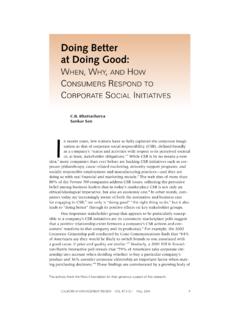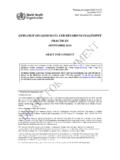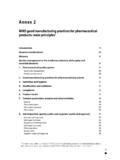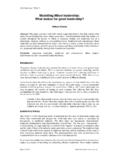Transcription of Guide to good dairy farming practice - Home | …
1 ISSN 1810-0708. 8. FAO ANIMAL PRODUCTION AND HEALTH. guidelines Guide TO good . dairy farming practice . Cover photographs: Left and center: IDF. Right: FAO/Alberto Conti 8. FAO ANIMAL PRODUCTION AND HEALTH. guidelines Guide TO good . dairy farming practice . Published by FOOD AND AGRICULTURE ORGANIZATION OF THE UNITED NATIONS. and INTERNATIONAL dairy FEDERATION. Rome, 2011. The first edition of this Guide was originally published by the Food and Agriculture Organization of the United Nations and the International dairy Federation (IDF) in English as Guide to good dairy Farmining practices , 2004.
2 It is available at and Recommended citation FAO and IDF. 2011. Guide to good dairy farming practice . Animal Production and Health Guidelines. No. 8. Rome. The designations employed and the presentation of material in this publication do not imply the expression of any opinion whatsoever on the part of the Food and Agriculture Organization of the United Nations, or of the International dairy Federation (IDF) concerning the legal status of any country, territory, city or area or of its authorities, or concerning the delimitation of its frontiers or boundaries. The mention of specific companies or products of manufacturers, whether or not these have been patented, does not imply that these have been endorsed or recommended by FAO or the IDF in preference to others of a similar nature that are not mentioned.
3 The views expressed in this information product are those of the author(s) and do not necessarily reflect the views of FAO or the IDF. ISBN 978-92-5-106957-8. All rights reserved. FAO and or IDF encourage reproduction and dissemination of material in this information product. Non-commercial uses will be authorized free of charge, upon request. Reproduction for resale or other commercial purposes, including educational purposes, may incur fees. Applications for permission to reproduce or disseminate FAO copyright materials, and all queries concerning rights and licences, should be addressed by e-mail to or to the Chief, Publishing Policy and Support Branch, Office of Knowledge Exchange, Research and Extension, FAO, Viale delle Terme di Caracalla, 00153 Rome, Italy.
4 FAO and IDF, 2011 (this revised edition). FAO and IDF, 2004 (original edition). iii Contents Foreword v Acknowledgements vi Introduction 1. A basis in good Agricultural practice (GAP) 1. About this Guide 1. Objective and scope 2. Other references of relevance 2. How the guidelines are presented 3. good dairy farming practices 5. 1. Animal health 5. 2. Milking hygiene 6. 3. Nutrition (feed and water) 7. 4. Animal welfare 8. 5. Environment 9. 6. Socio-economic management 10. Fact sheets 11. 1. Animal health 11. 2. Milking hygiene 17. 3. Nutrition (feed and water) 21. 4. Animal welfare 25. 5. Environment 30.
5 6. Socio-economic management 34. v Foreword dairy farmers' production systems worldwide need to be able to combine profitability with the responsibility of protecting human health, animal health, animal welfare and the envi- ronment. dairy farmers, as the primary producers in the supply chain, should also be given the opportunity to add value to their product by adopting methods of production that satisfy the demands of processors and customers. This Guide gives individual dairy farmers proactive guidance on how these objectives can be achieved on their farm. The Guide to good dairy farming practice has been written in a practical format for dairy farmers engaged in the production of milk from any dairy species.
6 When adopted, it will support the production and marketing of safe, quality-assured milk and dairy products. The Guide focuses on the relationship between consumer safety and economic, social and environmental management at the farm level. The Guide contains many individual practices that contribute to good dairy farming practice , covering the key aspects of animal health, milk hygiene, nutrition, welfare, the environment and socio-economic management. These practices have been drawn from best practice guidelines and existing assurance schemes around the world, and so individual practices will vary in their applicability to vari- ous dairying regions.
7 They are not intended to be legally binding and readers are encouraged to select and implement those guidelines that are of relevance to their situation. As such, this Guide aims to provide a genuine framework for dairy farm assurance schemes to be developed globally, giving individual countries and dairy farmers the oppor- tunity to develop schemes that are specific to their needs. MISSION STATEMENT. To elaborate a practical, farm orientated, globally achievable Guide to good dairy farm- ing practices for dairy farmers, covering key aspects of dairy farm management including: animal health, milk hygiene, animal nutrition, animal welfare, the environment and socio- economic management.
8 Helen Dornom Berhe G. Tekola Chair Director IDF/FAO Project Group of the Animal Production and Health Division IDF Standing Committee on Food and Agriculture Organization of Farm Management the United Nations vii Acknowledgements This new Guide updates the first edition produced by the IDF/FAO Task Force on good dairy farming practices in 2004. The IDF/FAO Project Group of the IDF Standing Committee on Farm Management includ- ed the following experts: Helen Dornom (AU) - Chair, R jean Bouchard (CA), Jude Capper (US), J Eric Hillerton (NZ), David Homer (GB), Eirini Fragkiadaki (GR), Jamie Jonker (US), Cheryl McCrindle (ZA), Marie Natacha (FR), Marcin Preidl (DE), M U Siddiqui (IN), Olaf Thieme (FAO) and Yong-Suk Son (KR).
9 The group was supported by other IDF experts who made an active contribution to the work: Elizabeth Berry (GB), Olivier Cerf (FR), Robin Condron (AU), Elisabeth Erlacher-Vindel (OIE), Ham Junsang (KR), Mohan Namjoshi (IN), Daniel Scholl (CA), Joerg Seifert (IDF), Rafal Artur Stachura (PL) and Vincent Turner (ZA). Special thanks must be given to Helen Dornom (AU) assisted by Robert Greenall (AU). for compiling the information into a coherent document. Thanks also go to Pierre Doyle of FIL-IDF Canada and Thierry Geslain of FIL-IDF France for ensuring the translation of the docu- ment from English to French and to Pedro Valentin-Gamazo of IDF Spain for taking charge of the translation into Spanish.
10 The FAO Animal Production and Health Division (AGA) arranged translation into other official working languages of FAO and the publication of the Guide . 1. Introduction A BASIS IN good AGRICULTURAL practice (GAP). good Agricultural practice for dairy farmers is about implementing sound practices on dairy farms collectively called good dairy farming practice . These practices must ensure that the milk and milk products produced are safe and suit- able for their intended use, and also that the dairy farm enterprise is viable into the future, from the economic, social and environmental perspectives.
















